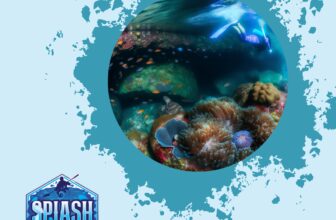
Ever wonder what lights up the dark depths of the ocean? While it might seem like another world down there, some amazing marine species have evolved the ability to produce their own light. This guide is for all the aspiring and beginner divers eager to explore the mesmerizing phenomenon of marine bioluminescence. Let's dive into what makes the underwater world glow and how you can experience it firsthand!
Introduction
Imagine diving into the ocean and being surrounded by tiny sparkles of light, as if swimming through a starry night sky. This isn't a scene out of a fantasy movie—it's a real phenomenon called marine bioluminescence. Simply put, bioluminescence is when living organisms produce their own light. For divers, understanding and experiencing bioluminescence is like unlocking a whole new dimension of the underwater world.
Why is Bioluminescence Important for Divers?
1. Extra Excitement and Wonder
- Identify Glowing Creatures: Spot and identify various bioluminescent organisms.
- Appreciate Unique Behaviors: Observe how these creatures use light for survival.
2. Environmental Respect and Protection
- Understand Delicate Ecosystems: Learn about the habitats of bioluminescent organisms.
- Promote Conservation: Encourage the protection of these unique environments.
3. Enriched Diving Experience
- Deepened Connection: Feel more connected to the astonishing natural world beneath the waves.
- Enhanced Enjoyment: Make your dives more memorable and fulfilling.
Curious to dive into the details? Read on, and we'll guide you through the fascinating world of marine bioluminescence.
What is Marine Bioluminescence?
Marine bioluminescence is the production and emission of light by living organisms in the ocean. When you see those mesmerizing blue and green glows beneath the waves, that's bioluminescence in action. It's not just a random twinkle—it's a fascinating natural phenomenon rooted in a bit of simple chemistry.
At its core, bioluminescence happens through a chemical reaction. Most commonly, this involves a molecule called luciferin, which reacts with oxygen and is catalyzed by the enzyme luciferase. When these components come together, light is produced. Think of it as a tiny, natural flashlight embedded within the organisms.
So, why do marine creatures light up? They have a range of motives, all driven by survival. For some, like the tiny dinoflagellates, bioluminescence serves as a defense mechanism, startling predators when disturbed. Deep-sea fish and certain squid and octopuses use bioluminescence to communicate or to attract prey by mimicking other organisms. Others use this talent to blend in with the light filtering from above to avoid being seen by predators lurking below—a technique known as counterillumination.
Understanding bioluminescence isn't just a cool science fact; for divers, it's an opportunity to witness an extraordinary aspect of marine life.
Notable Bioluminescent Species
When you're diving into the mysteries of the ocean, knowing what to look for can make your underwater adventure even more thrilling. Here are some bioluminescent species that you might come across:
Dinoflagellates
These tiny plankton are the rock stars of marine bioluminescence. You'll often find them lighting up the waves at night, creating a surreal, glowing blanket over the water. The effect, often called "sea sparkle," is caused by the movement of the water, which triggers their light-producing chemical reactions.
Jellyfish
Diverse species of jellyfish, like the comb jelly, produce mesmerizing pulses of light. Some emit a constant glow, while others flash brilliantly to startle predators. When diving, you might spot these luminescent orbs drifting gracefully through the water, their bodies casting an ethereal light around them.
Squid and Octopuses
Cephalopods like certain squids and octopuses use bioluminescence for more tactical purposes. Some squids, like the firefly squid, produce dazzling displays to communicate or attract mates. Others might emit light to confuse predators or to hide their silhouette against the surface light, a tactic known as counter-illumination.
Deep-Sea Fish
In the dark abyss of the deep sea, fish like the anglerfish have adapted to use light in creative ways. The anglerfish, for instance, uses a bioluminescent lure to attract prey right into its mouth. There's also the flashlight fish, named for the bioluminescent bacteria in pouches under its eyes, which it can "blink" on and off to communicate or disorient predators.
Fireflies of the Sea – Ostracods
These tiny crustaceans are often called the "fireflies of the sea." They emit light in short bursts to escape predators or during mating rituals. Diving in the right areas, you might witness these miniature bursts of blue light, creating an underwater fireworks display.
Knowing these species can help you appreciate the silent, glowing concert taking place in the depths of the ocean. Whether they're using their light to communicate, attract a meal, or avoid becoming one, these organisms add a magical dimension to your diving experience. So keep your eyes peeled and your curiosity piqued—there’s a whole glowing world waiting beneath the waves.
Best Places for Bioluminescent Diving
If you're geared up and ready to see the underwater glow for yourself, the next step is choosing the right spot. Here’s a rundown of some of the best places to witness bioluminescent displays in their full glory:
Mosquito Bay, Puerto Rico
Renowned as one of the brightest bioluminescent bays in the world, Mosquito Bay offers an astonishing display of shimmering blue-green light. The glow here is mainly due to a high concentration of dinoflagellates, tiny plankton that light up when disturbed. Nighttime kayak tours are highly recommended, as each paddle stroke causes a burst of bioluminescence, making the water look like it's filled with twinkling stars. Whether you’re snorkeling or simply floating on the surface, the experience is nothing short of magical.
Halong Bay, Vietnam
Halong Bay’s serene emerald waters don’t just look amazing above the surface—they hide a mystical underwater light show. Here, bioluminescent plankton often illuminate the bay, most spectacularly visible during night dives or even casual swims. The bay's secluded inlets and caves make for a quiet, eerie, and otherworldly diving experience. Beginners will find the calm waters ideal for their first bioluminescent dive.
Toyama Bay, Japan
For those willing to journey to Japan, Toyama Bay provides a unique spectacle: the firefly squid. These small cephalopods emit a vivid blue light from tiny photophores on their bodies, which serve to attract mates and confuse predators. The firefly squid migrate close to the surface during their breeding season, typically from March to June. Divers in Toyama Bay during these times can witness clouds of glowing squid, a sight that rivals any underwater light display in its sheer beauty and vibrancy.
No matter which destination you choose, each offers its own unique flavor of underwater luminescence. Remember, the visibility largely depends on local conditions and timing. Always check the best seasons and plan your trip accordingly to enhance your chances of a dazzling dive.
Preparing for a Bioluminescent Dive
Getting ready for a bioluminescent dive isn't too different from prepping for a standard dive, but a few key considerations can make all the difference in your experience.
Equipment Needed
For a bioluminescent dive, you'll need your standard snorkel or scuba gear:
- Mask
- Fins
- Wetsuit
- Diving tank (if you’re scuba diving)
One piece of specialized equipment you might want to invest in is a low-light camera:
- GoPro with underwater housing
- High-end underwater camera
Capturing the ethereal glow of bioluminescence can be a game-changer for your diving memories.
Choosing the Right Time
Timing can make or break a bioluminescent dive:
- Aim to dive during the darker phases of the moon (e.g., new moon)
- The less ambient light from the moon and surroundings, the more prominent the bioluminescence will appear
- Check local conditions and moon phases before planning your trip to ensure you're diving during optimal conditions
Safety Considerations
Safety should always be a priority:
- Dive with a buddy, especially when night diving
- Familiarize yourself with the local marine life
- Some bioluminescent creatures can sting or bite, so know what to avoid
- Be aware of any currents or underwater hazards specific to the dive site
- Having a local guide can provide invaluable insight and enhance both your safety and enjoyment of the dive
By following these tips, you'll be well-prepared to experience the ocean’s glowing wonders safely and memorably. So, gear up, plan your dive strategically, and get ready for a light show like no other!
What to Expect During a Bioluminescent Dive
Imagine slipping beneath the surface into a dark, mysterious world, where each flick of your fin sets off a cascade of glowing blue-green sparks. That’s what a bioluminescent dive feels like. You're essentially swimming through a galaxy, with light erupting in response to your every movement. Before you dive in, here’s what you can expect.
Visual Effects
Your first breath underwater at night might feel a bit eerie, but as your eyes adjust, you'll start to notice tiny flashes and streams of light. Swirling your hand gently through the water will set off trails of bioluminescence, akin to a painter's brush on a dark canvas. Each bubble you exhale can ignite bursts of light, making you feel like an underwater magician.
Interaction with Organisms
Bioluminescent organisms like dinoflagellates and certain jellyfish are often the stars of this show. They light up when disturbed, meaning your very presence is what triggers their glow. This is part of their natural defense mechanism—imagine the spectacle as these microscopic creatures react to your touch, shimmering with every movement you make.
Atmosphere
The overall ambiance of a bioluminescent dive is almost surreal. It’s tranquil, almost trance-like. The darkness envelops you, but the scattered luminescent lights provide a comforting, almost mystical glow. It feels otherworldly, as if you’ve been transported to a different dimension where the normal rules of reality don’t apply.
Otherworldly Feeling
One of the most remarkable aspects of a bioluminescent dive is the profound sense of peace it brings. The ocean at night is a quiet refuge, and the gentle, glowing lights only enhance the serenity. This is a time to slow down and take in the unique beauty around you. It's a tranquil experience that connects you deeply with the ocean’s hidden wonders, making every moment under the waves unforgettable.
So, if you're ready to add a little magic to your diving adventures, bioluminescent dives might be just what you need. Whether you're a novice or an experienced diver, the experience is accessible and worth every second. Plus, it’s a great reminder of how magnificent and mysterious the ocean really is.
Capturing the Moment
So, you want to share the awe-inspiring beauty of bioluminescence with your friends, or perhaps just document your own underwater adventure? Capturing bioluminescent organisms on film can be tricky, but with the right preparation, you can create some stunning images and videos.
Camera Settings
First things first—ditch the flash. It may seem counterintuitive, but using a flash will wash out the delicate light produced by marine organisms. Instead, utilize low-light or underwater modes on your camera. These settings are specifically designed to handle the low-light conditions you're dealing with during a bioluminescent dive. Adjust your ISO settings towards the higher end, but be mindful of noise; too high, and your pictures will turn out grainy.
Ideal Equipment
For equipment, quality trumps quantity. Use underwater cameras with excellent low-light performance, such as the GoPro with proper housing or cameras from brands like SeaLife. If you're planning to shoot videos, action cams are particularly popular due to their compact size and durability. Make sure your setup includes an appropriate underwater housing to protect against leaks and pressure.
Patience and Practice
Capturing bioluminescence is a game of patience and timing. These organisms often light up in response to movement, so experiment with gentle waves of your hand or fins to make them glow. But don't go overboard with movement; too much stirring can disrupt the scene and create murky waters, ruining the shot. Spend some time practicing, take multiple shots, and learn to anticipate the right moment to click the shutter.
In summary, capturing the magic of bioluminescence requires a bit of technical know-how and a lot of patience. But get it right, and you'll have mesmerizing images that are guaranteed to inspire and amaze.
Interconnecting with Other Ocean Phenomena
Just as fascinating as bioluminescence itself, the way it interconnects with other ocean phenomena offers a broader perspective on the ocean's intricate web of life. Bioluminescence isn’t an isolated spectacle. It often ties into patterns and behaviors observed in the marine world, supporting a more profound understanding of ocean ecosystems.
Role in the Food Web
Bioluminescent organisms often contribute to the food web in significant ways, either as prey or predator.
- Attraction: Glowing bodies of certain deep-sea fish and squid can attract smaller creatures, making them easier to catch.
- Defense: Luminescence can serve as a defense mechanism, deterring predators or confusing them.
Understanding these interactions can help divers anticipate where to find these glowing wonders.
Environmental Health Indicators
Bioluminescence can sometimes signal the health of marine environments.
- Dinoflagellates: A bloom of bioluminescent dinoflagellates, responsible for the glowing waves seen in places like Mosquito Bay, can be linked to nutrient-rich waters brought by upwelling or pollution events.
- Water Quality: These connections reveal the impact of water quality and help guide conservation efforts.
Related Articles
Seabird Conservation
Check out our detailed article on Seabird Conservation. Many seabirds rely on the smaller fish and plankton that form the base of the bioluminescent food web. Their survival is intricately linked to the balance of marine ecosystems, indicating the broader importance of bioluminescence beyond its visual appeal.
Ocean Gyres
Another related phenomenon to explore is Ocean Gyres. Gyres influence nutrient distribution, which can affect the prevalence of bioluminescent organisms. These massive water circulations help shape where and how nutrient-rich waters, which support bioluminescent plankton blooms and other life forms, are distributed across the globe.
Appreciating the Interconnections
By understanding these interconnections, beginner divers can gain a deeper appreciation for the ocean. Spotting that magical glow is just one piece of a larger, breathtaking puzzle. So, as you prepare for your bioluminescent dive, remember that the ocean's light show is part of an incredible, interconnected marine world waiting for you to explore.
Conclusion
Marine bioluminescence is one of the ocean's most captivating phenomena, acting like a natural light show that offers an otherworldly experience underneath the waves.
For Beginner Divers
For beginner divers, it provides:
- An awe-inspiring introduction to the underwater world.
- A deeper appreciation for the intricate ecosystems thriving in the dark.
Why You Should Dive In
If the idea of glowing waves, twinkling lights, and a tapestry of luminous creatures excites you, then taking the plunge to witness bioluminescence firsthand is an adventure well worth pursuing. It's a unique opportunity to connect with marine life in a way that few get to experience.
Responsibility of Divers
However, as mesmerizing as these phenomena are, it's crucial to remember our role as guardians of the ocean:
- Maintain a safe distance from organisms.
- Never disturb their natural habitats.
By practicing responsible diving, we ensure these natural wonders endure, enchanting divers for generations to come.
Final Thoughts
So gear up, dive in, and let the ocean's glowing spectacle inspire you. The underwater world is waiting, ready to unveil its secrets to those willing to take the plunge.







